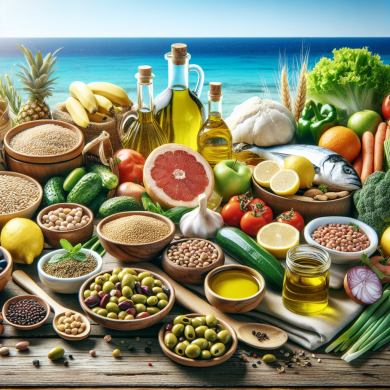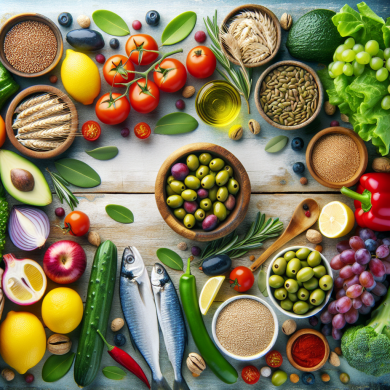Kickstart Mediterranean Diet: Simple Steps Guide
Introduction to the Mediterranean Diet
The Mediterranean diet is more than just a diet; it’s a way of life that emphasizes whole foods, healthy fats, and a balanced approach to eating. Originating from the traditional dietary patterns of countries bordering the Mediterranean Sea, this diet is lauded for its health benefits and sustainability. At its core, the Mediterranean diet encourages the consumption of fresh fruits, vegetables, legumes, nuts, and whole grains, while promoting healthy fats, such as olive oil, and moderate consumption of fish and poultry.
Benefits of the Mediterranean Diet
Research has consistently shown that the Mediterranean diet can lead to numerous health benefits. These include a reduced risk of cardiovascular diseases, improved brain function, and a lower incidence of chronic illnesses such as type 2 diabetes and certain types of cancer. Furthermore, this diet has been linked to increased longevity and better weight management due to its emphasis on nutrient-dense, satisfying foods.
Simple Steps to Kickstart Your Mediterranean Diet
Start with Fresh Produce
At the heart of the Mediterranean diet is a wide array of fruits and vegetables. Aim to incorporate a variety of colors and types into your meals. This not only ensures a broad spectrum of nutrients but also keeps meals interesting and flavorful. Fresh salads, roasted vegetables, and fruit-based desserts are excellent choices. Strive to fill half of your plate with these plant-based foods.
Embrace Healthy Fats
Unlike some diets that restrict fat intake, the Mediterranean diet encourages the consumption of healthy fats. Olive oil is a staple, used both for cooking and as a dressing. It’s rich in monounsaturated fats, which are heart-friendly. Additionally, include sources of omega-3 fatty acids such as fatty fish (salmon, mackerel, sardines) at least twice a week, and consider nuts and seeds as snacks or salad toppings.
Choose Whole Grains
Whole grains form the base of many Mediterranean meals. Opt for whole-grain bread, pasta, rice, and other grains like quinoa, farro, and barley. These foods are high in fiber, aiding digestion and providing a steady release of energy throughout the day. Experiment with different grains to add variety and texture to your meals.
Moderate Dairy and Meat Consumption
In the Mediterranean diet, dairy products are consumed in moderation, primarily in the form of yogurt and cheese. Choose high-quality, preferably organic dairy products and limit the intake of red meat, focusing instead on lean proteins such as poultry and fish. Red meat should be eaten sparingly, perhaps once a week, to maintain heart health.
Incorporate Legumes
Legumes are a powerhouse of nutrients and an excellent source of plant-based protein. Incorporate beans, lentils, and chickpeas into your diet as a substitute for meat or as a complement to meals. They are versatile and can be added to soups, stews, salads, or served as a main dish.
Enjoy Wine in Moderation
Wine, particularly red wine, is often included in the Mediterranean diet but should be consumed in moderation. This typically means one glass per day for women and up to two for men. Wine is best enjoyed with meals, enhancing the dining experience while providing antioxidants.
Savor Your Meals
The Mediterranean diet is not just about what you eat but also how you eat. Take time to savor your meals, focusing on the flavors and textures. This mindful approach to eating can enhance satisfaction and prevent overeating. Meals are often seen as a social occasion, bringing family and friends together, which contributes to overall wellbeing.
Sample Mediterranean Meal Plan
Breakfast
- Greek yogurt with mixed berries and a drizzle of honey
- A slice of whole-grain bread with avocado spread
- Herbal tea or a small cup of coffee
Lunch
- Grilled chicken salad with mixed greens, cherry tomatoes, cucumber, olives, and feta cheese, dressed with olive oil and lemon juice
- A side of whole-grain pita bread
- Fresh fruit for dessert
Dinner
- Pan-seared salmon with a side of roasted vegetables (zucchini, bell peppers, and eggplant)
- Quinoa salad with chickpeas, parsley, and lemon vinaigrette
- A glass of red wine (optional)
Snacks
- A handful of almonds or walnuts
- Sliced apple with a dollop of almond butter
Conclusion
Transitioning to a Mediterranean diet is a journey toward a healthier lifestyle. It emphasizes balance, variety, and enjoyment of food, making it both sustainable and enjoyable. By following the simple steps outlined above, you can kickstart your Mediterranean diet and start reaping the numerous health benefits it offers. Remember, the key is to make gradual changes and listen to your body’s needs, ensuring a balanced and fulfilling approach to eating.















Add comment